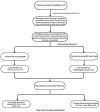Ozone Therapy as an Adjuvant in the Treatment of Periodontitis
- PMID: 38002690
- PMCID: PMC10672703
- DOI: 10.3390/jcm12227078
Ozone Therapy as an Adjuvant in the Treatment of Periodontitis
Abstract
The current study aimed to assess the efficacy of ozone therapy in the treatment of stage II and stage III periodontitis. This prospective split-mouth study selected patients who were diagnosed with either stage II or stage III periodontitis. All patients were treated with scaling and root-planing (SRP) on the control side and SRP with ozone therapy on the test side. Probing depth (PD), clinical attachment loss (CAL), O'Leary plaque index (PI), and bleeding on probing (BOP) scores were recorded at baseline and six weeks after the SRP treatment. A total of 46 patients were selected for this study, including 31 males and 15 females. All periodontal variables (PD, CAL, PI, and BOP) showed significant changes (p < 0.0001) from baseline to six weeks. Moreover, significant changes (PD = 0.0001, CAL = 0.0001, PI = 0.042 and BOP = 0.0001) were also observed between the control and test sides. Gender showed no significance on periodontal variables (p > 0.05) except PD on the test side (p = 0.030). In addition, periodontal stages and grades showed no significant changes (p > 0.05) in any periodontal variables on both sides. Ozone therapy significantly improves the periodontal condition compared to SRP treatment alone. However, the stages and grades of periodontitis do not influence the outcome of ozone therapy.
Keywords: ozone therapy; periodontitis; stages and grades of periodontitis.
Conflict of interest statement
The authors declare no conflict of interest.
Similar articles
-
The effectiveness of scaling and root planing with combined application of air polishing and Nd:YAG laser in periodontal pockets of stage III grade C periodontitis patients: a single-blinded randomized clinical trial.Clin Oral Investig. 2022 Aug;26(8):5459-5469. doi: 10.1007/s00784-022-04513-x. Epub 2022 May 3. Clin Oral Investig. 2022. PMID: 35505199 Clinical Trial.
-
Quadrant root planing versus same-day full-mouth root planing. I. Clinical findings.J Clin Periodontol. 2004 Feb;31(2):132-40. doi: 10.1111/j.0303-6979.2004.00461.x. J Clin Periodontol. 2004. PMID: 15016039 Clinical Trial.
-
Comparative evaluation of combined efficacy of methylene blue mediated antimicrobial photodynamic therapy (a-PDT) using 660 nm diode laser versus Erbium-chromium-yttrium-scandium-gallium-garnet (Er, Cr: YSGG) laser as an adjunct to scaling and root planing on clinical parameters in supportive periodontal therapy: A randomized split-mouth trial.Photodiagnosis Photodyn Ther. 2022 Sep;39:102971. doi: 10.1016/j.pdpdt.2022.102971. Epub 2022 Jun 20. Photodiagnosis Photodyn Ther. 2022. PMID: 35738551 Clinical Trial.
-
Short-term clinical and immunologic effects of scaling and root planing with Er:YAG laser in chronic periodontitis.J Periodontol. 2008 Jul;79(7):1158-67. doi: 10.1902/jop.2008.070600. J Periodontol. 2008. PMID: 18597597 Clinical Trial.
-
Impact of bariatric surgery on periodontal status in an obese cohort at one year of follow-up.Med Int (Lond). 2021 Jun 11;1(2):4. doi: 10.3892/mi.2021.4. eCollection 2021 May-Jun. Med Int (Lond). 2021. PMID: 36699146 Free PMC article. Review.
Cited by
-
Unlocking Healing: Ozone Therapy's Breakthrough in Oral Lesion Management - A Narrative Review.J Pharm Bioallied Sci. 2025 Jun;17(Suppl 2):S1076-S1079. doi: 10.4103/jpbs.jpbs_292_25. Epub 2025 Jun 18. J Pharm Bioallied Sci. 2025. PMID: 40655745 Free PMC article. Review.
-
Effects of ozone therapy as an adjuvant in the treatment of periodontitis: a systematic review and meta-analysis.BMC Oral Health. 2025 Mar 4;25(1):335. doi: 10.1186/s12903-025-05639-6. BMC Oral Health. 2025. PMID: 40038617 Free PMC article.
-
Effects of systemic ozone administration on the fresh extraction sockets healing: a histomorphometric and immunohistochemical study in rats.J Appl Oral Sci. 2024 May 13;32:e20230412. doi: 10.1590/1678-7757-2023-0412. eCollection 2024. J Appl Oral Sci. 2024. PMID: 38747807 Free PMC article.
-
Unveiling the Therapeutic Potential of Systemic Ozone on Skin Wound Repair: Clinical, Histological, and Immunohistochemical Study in Rats.Biomed Res Int. 2024 Aug 20;2024:6623114. doi: 10.1155/2024/6623114. eCollection 2024. Biomed Res Int. 2024. PMID: 39502273 Free PMC article.
-
Effectiveness of Ozone Therapy in Non-Surgical Periodontal Treatment: A Meta-Analysis of Topical Applications.J Clin Med. 2025 Jul 18;14(14):5124. doi: 10.3390/jcm14145124. J Clin Med. 2025. PMID: 40725817 Free PMC article. Review.
References
-
- Caton J.G., Armitage G., Berglundh T., Chapple I.L., Jepsen S., Kornman K.S., Mealey B.L., Papapanou P.N., Sanz M., Tonetti M.S. A new classification scheme for periodontal and peri-implant diseases and conditions—Introduction and key changes from the 1999 classification. J. Clin. Periodontol. 2018;45:S1–S8. doi: 10.1111/jcpe.12935. - DOI - PubMed
LinkOut - more resources
Full Text Sources
Research Materials
Miscellaneous


